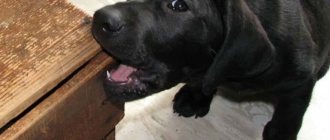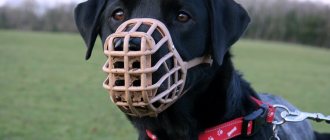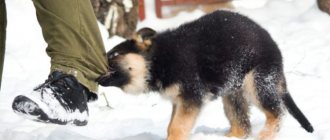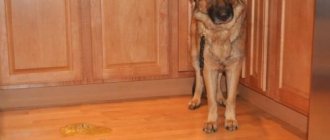Why do dogs behave this way?
If an adult dog does not obey and constantly goes in the wrong direction, he shows disrespect, and the puppies thus establish themselves in the role of leader. This behavior needs to be stopped. By jerking the leash, the dog can injure its neck or break from its leash. Representatives of large or medium breeds, for example, Dobermans, Shepherds, Caucasians, with a sharp jerk can damage the owner's hand.
Sometimes the dog pulls on the leash, guided by innate instincts or trying to give a signal. This applies to:
- guide dogs;
- service dogs searching for something;
- sledding breeds not trained to walk properly.
In addition, the animal may become frightened or experience other emotional distress. In such cases, behavioral adjustments are not necessary.
Usually people themselves provoke bad behavior in their pets. Dog handlers identify five common mistakes made by owners:
- They ignore disobedience in childhood and persistently demand that an adult dog behave correctly on the street without preparation. You need to accustom your animal to walks gradually, starting from three months.
- They rarely walk their pets. The dog tries to get off the leash because he understands that he will soon be driven home and tries to spend more time in the new territory.
- They jerk the leash sharply when the dog changes trajectory. Before the jerk, the leash is slightly loosened: the dog begins to think that the tense position will protect it from uncomfortable sensations.
- They follow the pet everywhere. The owner should walk the dog, and not vice versa. By allowing the animal to pull you wherever it wants, you help establish it as a leader.
- They scold an untrained dog for the slightest disobedience. The animal cannot immediately understand what is required of it, and constant punishment can cause fear of the street and hatred of the leash.
Is this normal
How to stop a dog from barking at the dog and at everyone
There are cases when a tight leash is normal. Some dog breeds instinctively pull on a leash. But this does not mean that after such a walk the owner should return home with a shoulder injury.
A dog may pull sharply on the leash if it is frightened and tries to run away. This also happens if she experiences aggression or wants to attack. Service animals constantly pull on their leash to show the way. Police dogs that are on the trail of a criminal can suddenly pull the dog handler behind them. If the owner left the dog on the street and went into the store, after a long absence the animal rejoices at the owner’s arrival.
Sometimes a dog pulls its owner along because it is too inquisitive
However, it is worth teaching your pet not to pull the leash and drag the owner along without reason. If it is a small breed, then you can handle it. But if a Labrador pulls sharply, in such a situation it is very easy to get injured.
Note! During a normal walk with your four-legged friend, the leash should sag a little, but not drag on the ground.
How to stop a dog from pulling on a leash
To wean an adult dog from pulling on a leash, you need to let it understand that walking next to its owner is much more comfortable. Patience and perseverance are important when training. You can train a puppy in two weeks, but retraining an adult pet can take a month.
During the training period, use only one leash. During walks, it should be slightly lowered so that the dog can sniff the territory. You will have to give up tape measures, as they work on the principle of a tight cord: it will be inconvenient to control the animal, and the dog will also get used to the pressure on the neck.
How do you encourage pulling on the leash?
Before blaming your pet, analyze what you personally did to accustom your pet to inappropriate behavior. Surely you did not try to wean the puppy from pulling on the leash and this became a problem only when the dog grew up and became stronger. Perhaps you adopted a grown-up or adult dog that is not accustomed to tackling and immediately began to scold the pet for disobedience. Of course, you need to raise a four-legged animal, but first, get rid of your own bad habits:
- You are walking, not you - this means you are not walking in the direction the dog is pulling! We lower the leash to its maximum length, giving the dog room to sniff, but no more. We move only in the direction you have chosen and encourage the dog to follow your example.
- Overexcited behavior, aggression, cowardice, leash rushing and harsh barking should not be encouraged. You must distract the dog, redirect its attention to a toy or commands.
- Forget about jerking! In many dog training manuals, there is a method of parforce or tug, where the dog is punished or stimulated with physical force. In the case of tensioning the leash, this is a disastrous idea, especially if we are talking about an adult dog. To make a jerk, you need to slightly release the tension on the collar and jerk. The pet learns the following: if the collar is not constantly pulled, it means that the jerk will be unpleasant for me. Consequences – the dog tries even harder and pulls on the leash, avoiding punishment.
Choosing training accessories
For training to bring results, you need to choose the right accessories: a collar and a leash. You will also need treats to reward your pet.
Leash
A leash is a tool with which you can control the movements of your pet. During walks, it should be held in two positions: short, so that the dog walks next to your leg, and slightly longer, so that it can take a walk. The optimal leash length is 3–5 m. For large pets, thick leashes made of strong materials are needed, and for miniature breeds, thin ones. The carabiner should be securely attached to the collar, and the loop handle should fit comfortably in your hands.
Collar
The main criterion for choosing a collar is that the pressure should be gently and evenly distributed over the pet’s neck without injuring it. When choosing a collar, you need to pay attention to its width and principle of operation.
Width:
- 2–3 cm for puppies and adult animals of small breeds;
- 4–5 cm for medium and large pets;
- 5–12 cm for dog breeds with long necks (greyhounds, hounds).
Operating principle:
- A harness is needed for puppies and small dogs – this option is not suitable for large breeds;
- The halti (halter) provides even pressure not only on the neck, but also on the muzzle. The dog will experience discomfort, but will not damage its neck - ideal for training;
- A shock or shock collar is used only as a last resort for large, unruly or aggressive animals.
Choosing ammunition
You cannot achieve success without the right accessories! Even if it’s trivial, choose a comfortable, wide enough collar to suit the size of your pet. Believing that causing discomfort can speed up learning, owners buy chains or leather cords instead of collars - this is the wrong tactic. On the shelves of pet stores you can find many accessories that are convenient only at first glance. Let's look at the main types of ammunition:
- The leash is a strong ribbon with a loop and a carabiner at the ends. Leashes are divided into short, medium and loose. A loose leash (10–12 m) is used for training; a medium leash is suitable for walking.
- A tape measure is a very convenient, but destructive accessory for learning. The principle of roulette is to keep the leash taut. The advantage is that the tape does not drag on the ground and the dog does not get confused in it.
- A handle leash is a strong and short cord with a strong arm loop and a carabiner. Used for side-by-side walking, not suitable for remedial training.
- Parforce collar (strict) – if you want to train, but not force the dog to behave correctly, the accessory is also not suitable. The use of parforce is relevant only in exceptional cases.
- A choke collar is a loop that tightens and strangles the dog when the leash is pulled. A fair remedy for adult, large and untrained dogs.
- A halter is an underrated accessory that acts not on the neck, but on the dog's face when the leash is pulled. A halter is not a muzzle, but a corrective accessory that helps teach a dog to walk correctly without causing discomfort and pain.
- ESH (electric shock collar) - usually has 2 modes: vibration and shock. A vibration is a warning, a blow is a punishment. Use is relevant if incorrect behavior really threatens the dog itself or others.
- A harness is a convenient accessory for trained dogs; it does not restrict movement when walking.
How to teach a puppy to walk on a leash
If a dog constantly pulls on the leash as a child, then with age it will develop problems with the health of its hind legs, so teaching kids the correct behavior on the street is very important. You need to start at three months: by this time the pet will get used to its “equipment”, other animals and external stimuli.
Puppies are very active and curious, so before training you need to run a little or play with the dog so that he splashes out excess energy. For best results, you need to follow the rules:
- training should be carried out every day for two weeks;
- the first exercises should not last longer than 5–10 minutes;
- Gradually, the training time should be increased to half an hour;
- there is no need to give treats after each correct action - there should be one treat for every three verbal approvals.
Training with a puppy can be done at home using the “penalty points” method.
- Tease your pet with a toy.
- Fasten the leash and sit the puppy next to you.
- Throw the toy to the side and start moving towards it with the dog.
- If the puppy starts to pull on the leash, return to the starting point, while showing disapproval.
- Continue the exercise until you reach the end point with your pet.
If you decide to use treats instead of a toy, then put it in a bowl. Otherwise, the puppy will think that it is okay to pick up any food from the floor or ground.
Basic principles of training
You can teach your dog to walk calmly if you follow these rules:
- for the first exercises, look for a quiet place away from people and other animals;
- when the pet stops pulling the leash in a secluded place, the classes become more complicated - they are carried out on noisy streets;
- before training, give the fidget 10-20 minutes to go to the toilet and run around - a slightly tired pet learns lessons better;
- Duration of classes – 10-15 minutes;
- Several training sessions are carried out during one walk;
- exercises are repeated every walk: the principle “yesterday we did it, but today we’re lazy, we’ll repeat it tomorrow” will not work - systematicity is needed.
At first, the pet may not understand what is being asked of him. But after 2-4 lessons the first changes will appear.
You need to walk correctly with the dog on a slightly slack leash so that it does not stretch and does not touch the ground. Dog handlers have a saying: “walking a dog on a leash is the same as walking with it holding hands.”
What should not be done during behavior correction?
The main task of the handler is to wean the dog from tugging and pulling on the leash. Prohibited methods look like this:
- Violence against animals, constant shouting, swearing and a mechanical method of education. All actions are performed only if the pet is motivated and has positive reinforcement. That is, the pet must want to complete the task, understand that a reward awaits him for correct behavior, and strive to receive one.
- Using a tape measure. This is not exactly a method of correcting behavior, but rather ammunition for a four-legged animal. The fact is that while walking on it, the animal gets used to being at a distance from the owner. The tape measure is designed in such a way that it initially allows the pet to pull it.
- Drop the leash and run away from your student. It is especially dangerous to practice this action on puppies, because they will become frightened and may take actions that are far from the owner’s expectations. Some adult dogs are so independent that they will ignore the owner and run in the opposite direction, while others will remain standing in place, waiting for the person to get tired of the new “game”.
- Pretend to be a tree. This exercise means stopping while the dog is pulling on the leash and waiting for it to return to the left leg. A pointless exercise, because you can stand like this for an hour, or two, or longer. In addition, the four-legged dog can jerk the leash sharply, which will lead to injury to the owner (at best). The worst case scenario is that the pet will break loose and run away, and then you will have to look for it.
On the Internet you can find recommendations on the use of this or that ammunition that helps correct dog behavior. Halters and bridles actually play a significant role in this. Only adjustment occurs at the expense of causing pain to the animal. The best way to obedience a pet is contact and trust between him and the owner.
Pulling on the leash. The perfect walk?
Elvira-dacenko? Your problems are understandable and close to the majority.
If you want everyone (both you and the dog) to feel comfortable, you need to use a little subtlety with these same follow commands. Well, there are two of them. In addition to the “nearby” command, there is another, more relaxed one.
1) a strict command, when the dog walks as if glued, PUSHING his shoulder against your leg and LOOKING IN YOUR EYES(!). (this, by the way, is “nearby”)
The dog will not be able to move in this mode for a long time in street conditions. This command is used in certain conditions: at all kinds of tests, when crossing the street, in a crowd (in short, in extreme sports).
At the end of the tense section, the dog must be praised and given a relaxing command (or another command), i.e. It is MANDATORY to mark the end of execution. If you forget, the team will “float.”
When developing this “nearby” command, you need to ensure that the dog, when the command sounds, looks you in the face , and does not “smell the back of its head” and automatically corrects its position. If there is no look, then there will be no clear turns to the right, around and beautiful stops, it will “float”.
2) a soft command, when the dog calmly walks in the same direction and pace as you, with slight deviations to the sides within the length of (any) leash, without pulling it, looking where it wants and sniffing, i.e. “walks culturally” street" near you (come up with a name for the team yourself. I've "got off").
To develop an adequate reaction to any (absolutely any) command, an appropriate reaction to you is necessary. The dog should pay attention to you. CONCENTRATION ON YOU (in life). This is where you have problems.
Therefore, encourage (emotionally and with treats) any independent attention to you. for example, a dog walked, sniffed (even if in the direction you wanted and at the right pace), and then suddenly raised its head, looked (remembered about you) - immediately a treat for it and “good girl.” If the dog is distracted from other dogs for your sake, then immediately a banquet, kisses, games, SO that the dog friends dry up with envy and forget about their games.
Don't forget about this, especially at the very beginning.
At the same time, remember the rule: the dog enjoys a treat when it does not drown in food, a good word when it does not drown in the constant sounds from your mouth directed at it.
Do not abuse treats, touches, constant lisping and pronouncing her name in every way at home. By doing this you reduce the value of it all. And these are your training tools! (if you don’t want to resort to repressive measures).
I understand that I really want to express love. NIVApros! Express it by learning to play with your dog SO that she enjoys it. With and without toys, so that she doesn’t get bored with you and doesn’t look for entertainment on her own.
If you are about to vomit, if you don’t cuddle your dog, take a treat, go to the dog and for each completed command cuddle, kiss, hug, lisp, pick up (if you pick it up), etc. There’s no need to restrain yourself here!
And you will be happy!











